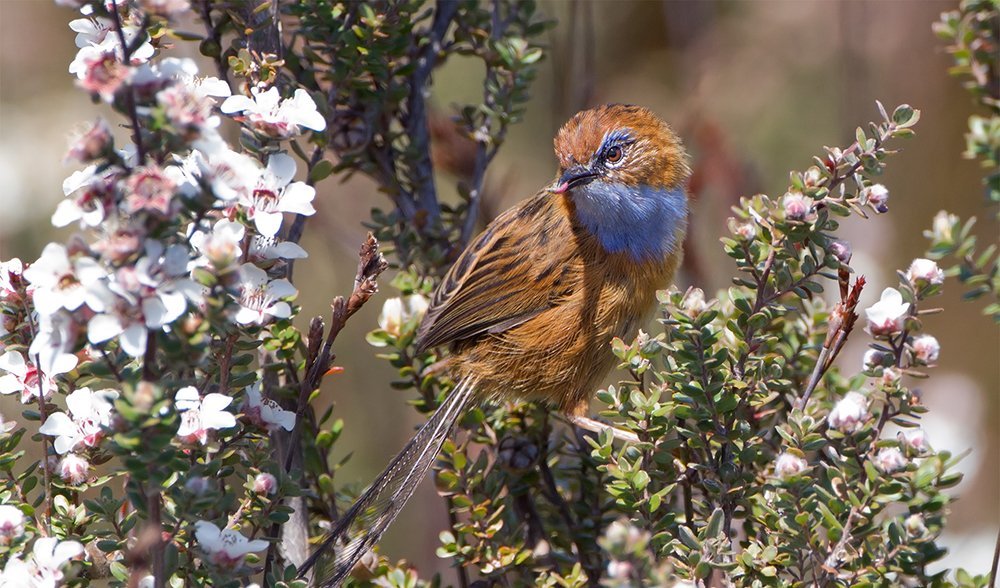Kangaroo Island cats’ days are numbered

THE DAYS OF feral cats on Kangaroo Island are numbered after the South Australian government outlined plans to eradicate all wild felines, and the bulk of domestic pets, in the next 15 years.
With no competition for food, the population of feral cats has risen to an estimated 5000 on the 440,500 hectare isle, causing widespread havoc for its endangered and endemic fauna – including the southern brown bandicoot, Kangaroo Island echidna, Kangaroo Island dunnart and southern emu wren.
There is evidence that densities could be higher on Kangaroo Island than on the mainland, warned Feral Cat Eradication Project Manager, Pat Hodgens. “But even in low numbers feral cats can have a devastating effect on native wildlife,” he said.

The southern emu wren ((Stipiturus malachurus, pictured here in Southwest National Park, Tasmania) is one of many native species threatened by feral cats on Kangaroo Island. (Source: JJ Harrison / Wikimedia)
Right now, Pat and his team are undertaking a range of non-lethal feral cat control trials, including cage and camera trapping, detector dogs and various lure techniques.
A cat-proof fence is planned to be erected on the Dudley Peninsula, to divide the island into two areas of study. Twenty feral cats will be fitted with radio-collars to monitor their movements, and test the efficiency of the barrier fence.
“We’ll also be working on grooming trap trials with the intention of having 12 traps set across the island in non-toxic ‘photo only’ mode,” explained Pat.
Each grooming trap is equipped with a camera to ascertain what species trigger the trap. In non-toxic mode, when a sensor is triggered these take a photo of the cat, rather than spray toxin onto it. Pat said he hopes to use these trials to avoid the accidental “capture” of curlews, bandicoots and echidnas.
A combination of local and trained detector dogs will be trialled in the more inaccessible areas – dense bush and thick scrub – to locate cats which can then be humanely euthanised.
Additionally, a mixture of audio, visual and scent lure traps will be road-tested to coax cats into more manageable areas for the purposes of baiting or trapping. These will include female mating calls, brightly coloured feather lures and “pongo” – a potent blend of cat faeces and urine.
RELATED: Natural-born killers: the problem with cats
While the team is conducting rigorous studies to investigate the potential use of toxins such as 1080, there are no concrete plans, Pat said, for the use of toxins or toxic-baits in the future.
“Kangaroo Island represents a great area for these kinds of trials, with its high density of cats and high proportions of small to medium mammals and birds. It’s an exciting study but for full-scale eradication it is likely we will have to use all techniques available to us. If we can successfully get grooming traps working here for example, they can then effectively be employed across the whole of Australia,” he said.
The project will also action “disease mitigation” strategies to stem the transmission of toxoplasmosis and sarcosporidiosis by wild cats amongst local livestock populations. These diseases can lower fertility and leave cysts on the muscle tissue of sheep, cattle and pigs.
As much as 70 per cent of Kangaroo Island sheep meat is currently affected by sarcosporidiosis, at a cost to the industry of approximately $2 million each year.
The team will also work on DNA profiling and data analysis for the cats – including measurements, age and stomach content examination – along with impact studies on native fauna, as well as rodents, to get an idea of the cats’ prey abundance on the island and to monitor the impacts of cat removal on them.
A new app, called FeralCatScan, has been developed to allow the community to assist and record any feral cat sightings on the island.
The question of domestic cat ownership on the island has caused quite a stir in the last few days, acknowledged Pat.
“Yes, ideally we’d be looking to phase out the bulk of pet cats in the long term. We are working extremely closely with the Kangaroo Island council and the community to investigate a permit system whereby some pet owners are permitted to keep de-sexed and registered cats on their properties without them contributing to the feral cat population,” Pat said. “It’s an ongoing discussion we need to have with our community”.
The island already exercises strict bylaws for cat ownership, requiring residents to register, desex and microchip all felines.
The end goal, said Pat, is to see Kangaroo Island become one of the world’s largest inhabited islands free of feral cats by 2030. Bruny Island, French Island, Christmas Island and Dirk Hartog Island are set to follow suit.
For more, visit the Natural Resources Kangaroo Island page.
READ MORE:
- New Zealand wants to be ‘predator-free’ by 2050
- Death-row dingoes plan blocked
- Controversial brumby cull proposed
- Invasive predators are eating the world’s animals to extinction




